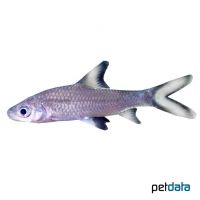Tricolor Sharkminnow (Balantiocheilus melanopterus)
| Tricolor Sharkminnow Balantiocheilus melanopterus | |
|---|---|
| Name | Tricolor Sharkminnow |
| Name Lat. | Balantiocheilus melanopterus |
| Synonym | Barbus melanopterus |
| Family | Carps |
| Family lat. | Cyprinidae |
| Order | Carps |
| Order lat. | Cypriniformes |
| Origin | Southeast Asia |
| Habitat | Rivers, lakes |
| Diet | Omnivore |
| pH | 6.0-7.0 |
| Behavior | Peaceful |
| Keeping | Group |
| Care Level | Moderate |
| Reproduction | Egg scatterer |
| Breeding | None reported |
| Life Span | 5-10 years |
| Protection | No |
| Metric Units | |
| Size | 20-35 cm |
| Temperature | 22-28 °C |
| Hardness | 5-10 °dH |
| Aquarium | ~ 500 l |
| US Units | |
| Size | 8"-14" |
| Temperature | 72-82 °F |
| Hardness | 89-178 ppm |
| Aquarium | ~ 130 gal |
Distribution and habitat
The distribution area of the shark barb is the river system of the Mekong and the Chao Phraya as well as waters on the Malay Peninsula, on Sumatra and Borneo. There they live in the larger and medium-sized rivers and lakes.
Maintenance
The aquarium should have varied, robust planting that provides shelter as well as swimming space, and roots that serve as a retreat
No ammonia, ammonium and nitrite should be detectable, the nitrate value should not exceed 100 mg/l. To ensure the water quality and oxygen content, a filter and heater adapted to the aquarium size is required, as well as lighting for the species-appropriate day-night rhythm of the animals.
Diet
They require mainly animal food, supplemented with vegetable. The food supply consists of live food, such as daphnia, cyclops, tubifex, mysis, artemia and mosquito larvae, which are also eaten in frozen form without any problems, plus commercially available frozen special food mixtures, supplemented with high-quality dry food (flakes, granules). To cover their need for plant food, they regularly require crushed peas, mashed leafy and wild vegetables or dry food with high plant content (e.g. spirulina, kelp).
Regular and varied feeding promotes health and prevents deficiency symptoms. Only feed as much as is eaten immediately (in a maximum of 10 minutes).
Behaviour and compatibility
They are sociable and lively fish that can be well socialized with fish that are not too small. At least 5, but preferably more shark barbs should be kept together. During comment fights (ritualized ranking fights) they can make short, loud creaking sounds.
Basically, only mutually compatible fish species with similar demands on water conditions and water temperature should be socialized.
Sex dimorphism
From 12 cm body length, males can be recognized by the almost straight abdominal line, which curves slightly inward (concave) in females.
Reproduction and breeding
There are no known reports of successful breeding in the aquarium.
Important
In soft, slightly acidic water they show the most beautiful coloration and the males an intense yellow on the fins.
The well-being of the fish should be checked regularly. Temperature should be checked daily, pH, hardness and nitrate levels at least fortnightly. Regular partial water changes are recommended, even if the contaminant level has not yet reached the upper limit. Sudden changes in water quality should be avoided. Newly introduced fish must be accustomed slowly to the water in the aquarium.
Further literature can be found in your pet store.
References
Text: Werner Winter; Image: petdata
Source: BMELV (1998): Tierschutzgutachten - Haltung von Zierfischen (Süßwasser); RIEHL & BAENSCH (2006): Aquarien Atlas Bd. 1, Mergus Verlag; ENGELMANN (2005): Zootierhaltung - Tiere in menschlicher Obhut: Fische, Verlag Harri Deutsch
- Gemäß § 21 Abs. 5 Tierschutzgesetz idgF
